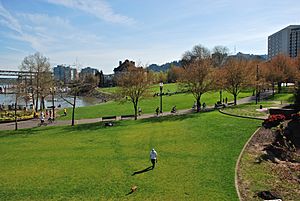Theodore Roosevelt Memorial (Portland, Oregon) facts for kids
| Coordinates | 45°30′49″N 122°40′27″W / 45.5135°N 122.6741°W |
|---|---|
| Location | Portland, Oregon, United States |
| Designer | Oliver L. Barrett |
| Material | Tufa |
| Height | 18 feet (5.5 m) |
| Completion date | 1939 |
| Dedicated to | Theodore Roosevelt and Spanish–American War veterans |
| Dismantled date | 1942 |
The Theodore Roosevelt Memorial was a special statue that honored Theodore Roosevelt, who was the 26th president of the United States. It also remembered the brave soldiers who fought in the Spanish–American War. This monument was first placed in Portland, Oregon, in a spot now called Tom McCall Waterfront Park.
An American artist named Oliver L. Barrett designed the memorial. It was built in 1939 and stood about 18-foot (5.5 m) tall. But something strange happened: the monument disappeared in 1942! It was supposed to be moved for a short time because a new road, Harbor Drive, was being built.
The memorial had a unique look. It featured a large, geometric statue made of a type of rock called tufa. This main statue didn't actually look like Roosevelt. There was also a smaller, more realistic sculpture of his face on the side. When it was first put up, many people didn't like it much. Still, it became one of artist Oliver L. Barrett's most famous works.
Contents
What Did the Memorial Look Like?
The Theodore Roosevelt Memorial was sometimes called the "Colossus of Portland." It was designed by Oliver L. Barrett, who was a sculptor and a professor at the University of Oregon.
Size and Materials
The monument was very tall, standing about 18-foot (5.5 m) high. It was made from a reddish rock called tufa, which came from Central Oregon. The whole statue weighed around 16 short tons (15,000 kg)! It was created to honor the soldiers who fought in the Spanish–American War.
The Statue's Meaning
The main statue was a man, but it didn't look like Theodore Roosevelt. Barrett, the artist, explained that it wasn't meant to be a picture of Roosevelt or anyone else. Instead, it was supposed to show Roosevelt's strong and determined spirit—someone who fought for what was right and built new things.
A newspaper, The Oregonian, also said that the statue was a general figure. It was meant to show Roosevelt's courage and determination in a modern art style. Barrett did carve a smaller, realistic picture of Roosevelt's face on the left side of the memorial. The base of the monument had an important message: "Our nation holds in its hands the fate of the coming years." Some people described the monument as "fascistic" because of its sharp, geometric shapes.
The Memorial's History
The idea for the memorial came from veterans of the Spanish–American War. They wanted to honor President Roosevelt.
How It Was Built
In July 1938, the University of Oregon announced that Oliver L. Barrett was working on the project. He was carving the statue from rock near Bend, Oregon. The university said it would be a "heroic" statue of a "symbolic, robed figure, holding a sword." It would be placed at the park's entrance. They also confirmed it would have Roosevelt's image on one side and a special message on the other.
The statue was planned to be 14 feet (4.3 m) tall. It was meant to capture the spirit of courage and determination. This was the same spirit that helped the battleship USS Oregon on its famous journey and inspired Theodore Roosevelt and his brave soldiers in the Spanish–American War. The money for the monument came from funds left over from a Spanish–American War veterans' meeting.
Where It Was Placed

The memorial was put in Battleship Oregon Park in February 1939. This spot was just south of the Hawthorne Bridge (which is now part of Tom McCall Waterfront Park). After it was installed, a person in charge of the memorial fund, E. C. Sammons, said he wanted to get rid of it. In 1941, he suggested replacing it with the Skidmore Fountain, but both statues stayed where they were.
The Mystery of Its Disappearance
The construction of Harbor Drive meant the monument had to be moved temporarily. Workers were supposed to cut the statue into pieces. Then, they would move it across the Willamette River for storage. However, the memorial simply vanished in 1942. No one knows exactly how it was removed or where it is now.
City officials tried to find the sculpture but couldn't. Even today, historians and art lovers are still looking for answers. At that time, Portland didn't keep good records of its public art, so the memorial wasn't officially listed. Some local Spanish–American War veterans asked about the monument. They didn't think much of it as art, but they were still upset that the city had lost it. City officials thought about moving another statue of Roosevelt, Theodore Roosevelt, Rough Rider, to the empty spot, but it never happened.
In 1972, a city official named Don Eckton remembered, "I think I remember it cracked when they were taking it apart... It wouldn't surprise me a bit if it isn't underneath that highway." He was talking about Harbor Drive. Amy Platt, a history manager at the Oregon Historical Society, shared some ideas. She said, "One theory is that it was demolished in place and buried in pieces in the park. Another is that some unknown person offered to haul it away and put it in a bunker somewhere." The mystery of the lost memorial continues!
See also
 In Spanish: Monumento conmemorativo a Theodore Roosevelt (Portland) para niños
In Spanish: Monumento conmemorativo a Theodore Roosevelt (Portland) para niños

